Best Time to Cold Call for B2B Sales in 2025: A Data-Backed Review
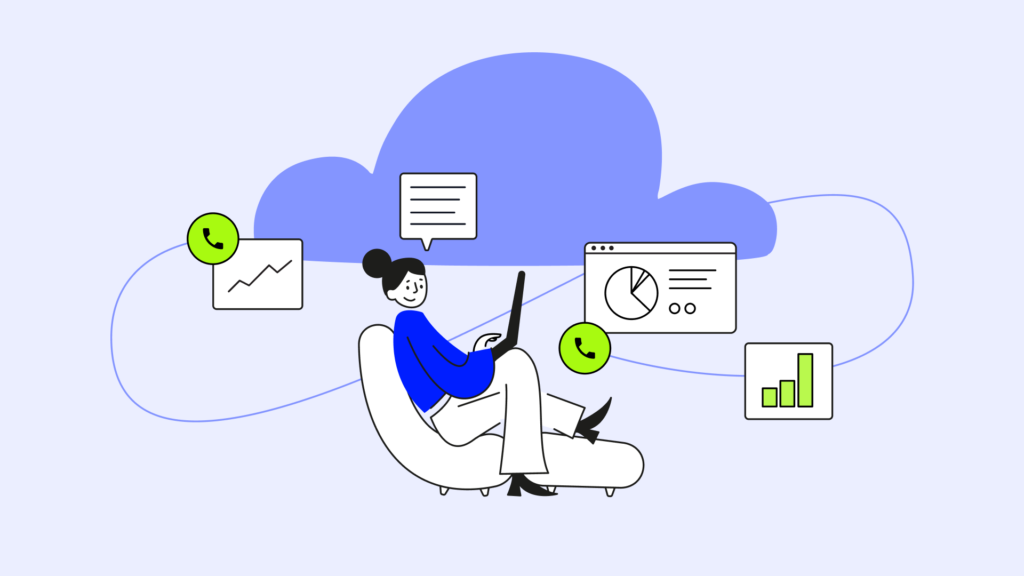
Struggling with cold calls that go nowhere? You might be dialing on the wrong days. According to HubSpot, sales reps get way better results on Wednesdays, connecting on 195 calls on the first try*.
Your timing could be the reason your calls aren’t connecting. Besides, cold calls made on Wednesdays are up to 2x more successful than those on Mondays and Fridays.
So if your calls keep getting ignored, it’s time to rethink your approach. This article explores the best and worst time to cold call statistically, so that you can get more people to pick up.
Key takeaways:
- Cold calling success heavily depends on when you reach out. Mid-morning (10 AM – 12 PM) and late afternoon (4 PM – 5 PM) are the most effective time slots.
- Research shows that cold calls on Wednesdays have the highest success rate, while Mondays and Fridays underperform significantly.
- Calling too early (before 10 AM), during lunch hours (12 PM – 2 PM), or too late (after 6 PM) leads to lower response rates and more ignored calls.
- Using AI-powered call solutions like CloudTalk’s CRM integrations, call monitoring, and power dialers can help optimize outreach, improve engagement, and increase conversion rates.
Boost your B2B sales with smarter cold calling.
What Are the Best Times to Cold Call?
Everyone who has experience with sales workflows knows that timing is everything, and B2B cold calling is no exception. This might seem like a small part of your campaigns’ structure. Nevertheless, calling at the right time can significantly impact your success.
When you reach prospects at the moment they’re more likely to engage, you improve connection rates. As simple as that. This would then contribute to higher conversions and boost your overall sales efficiency.
Thanks to multiple studies such as the one from InsightSquared, we now know the most effective day and time to cold call. Let’s take a look at these days and what makes the right time according to statistics.
Turn cold calls into hot leads with smarter, data-driven solutions!
Best Day to Cold Call
Not all days are equal when it comes to cold calling. Research shows that Wednesdays are the top-performing day for making outbound calls. This day significantly outperforms Mondays and Fridays.
Why?
Midweek tends to be the sweet spot. By Wednesday, professionals have moved past the chaos of Monday. They are fully engaged in their work but not yet mentally checking out for the weekend. This creates a prime opportunity to catch decision-makers when they’re focused but not too busy.
Stats published by HubSpot:
- Wednesday has the highest success rate, with 33% of cold calls connecting.
- Monday and Friday underperform, with only 15.7% and 10.4% of calls connecting, respectively.ň
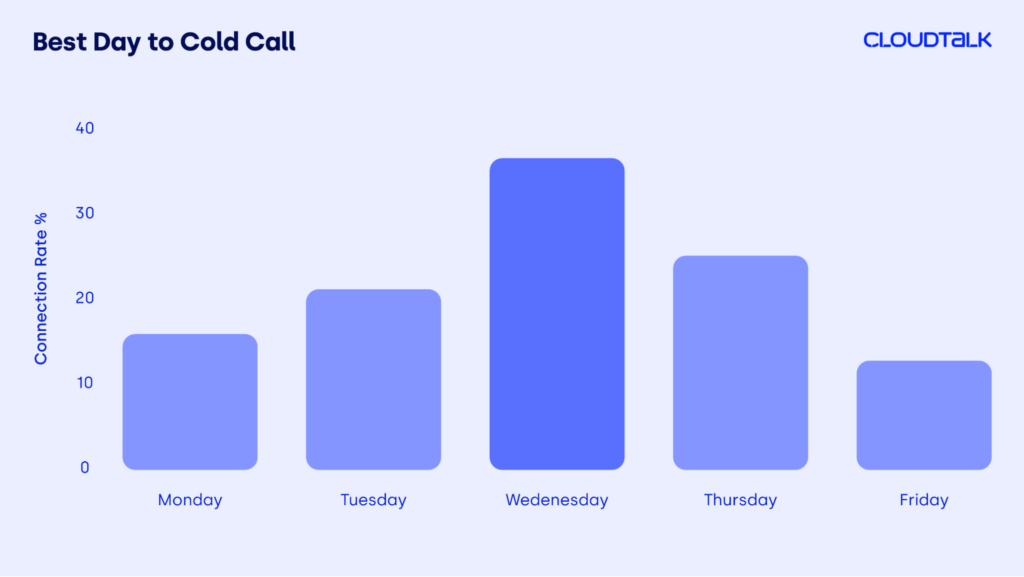
Best Time of the Day to Cold Call
The time of day you choose to cold call can make or break your success rate. Catching prospects when they’re available and in the right mindset is key to sparking productive conversations.
Why?
The best times to cold call B2B prospects are when they’re least distracted and most likely to take an unsolicited call. Late afternoon and mid-morning have been found to be the optimal windows for connection rates.
Stats:
- 4 PM – 5 PM is the most effective time, as people are winding down their work and more willing to engage (Revenue.io study).
- 10 AM – 12 PM is the second-best window, as professionals have settled into their day but are not yet overwhelmed (InsightSquared report).
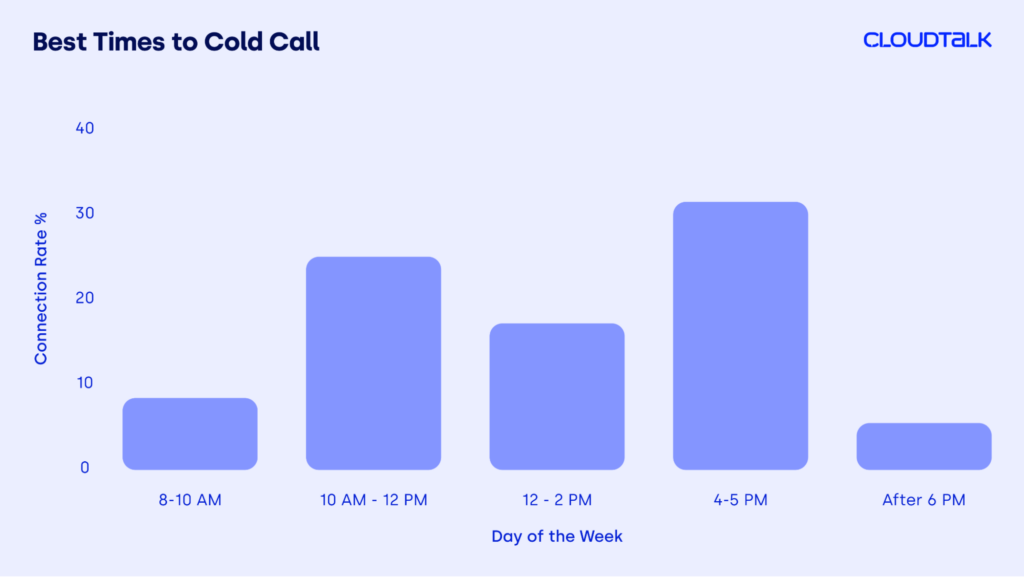
Why Timing Matters in Cold Calling
You might think that the success of your cold calling campaigns depends on your scripts and strategy. And you are not wrong. But besides what you say, when you say it also matters.
The timing of your calls affects the probability of them getting answered, ignored, or sent straight to voicemail. This is largely based on people’s availability, focus, and mood shifts throughout the day and week. Understanding these patterns can dramatically improve your success rates.
For instance, when professionals are winding down their workday, they cannot be bothered to hear your offers. The same goes for them earlier in the day, when they’re swamped with meetings, deadlines, and priorities. All these scenarios leave little room for unscheduled calls.
That’s why dialing at random can be a hit or miss game. Plan your outreach when your prospects are most likely to answer, and you’ll see more conversations, better engagement, and ultimately, more sales.
How should you know when is the best time to cold call? Industry experts have been studying this issue over the years, and now we have a concrete idea.
Improve your cold calling game with our proven scripts.
The Worst Times to Cold Call
Calling at the wrong moment can mean more voicemails, frustrated prospects, and wasted effort. You don’t want to interrupt someone during their personal time or when they’re overwhelmed with work. By doing so, you risk damaging your reputation before the conversation even begins.
Worst Day to Cold Call
Just as there are peak days for cold calling, there are days when your chances of success plummet. Mondays and Fridays rank as the worst days to cold call.
Why?
On Mondays, prospects are catching up from the weekend, prioritizing urgent tasks, and not in the right mindset for an unsolicited sales pitch. Fridays are just as bad. By then, most people are mentally winding down, checking out early, or focused on weekend plans rather than work.
Stats:
- Monday’s connection rate is just 15.7%.
- Friday fares even worse at 10.4%.
- Tuesday also performs poorly as people are still catching up from Monday, making it another suboptimal day for cold calling.
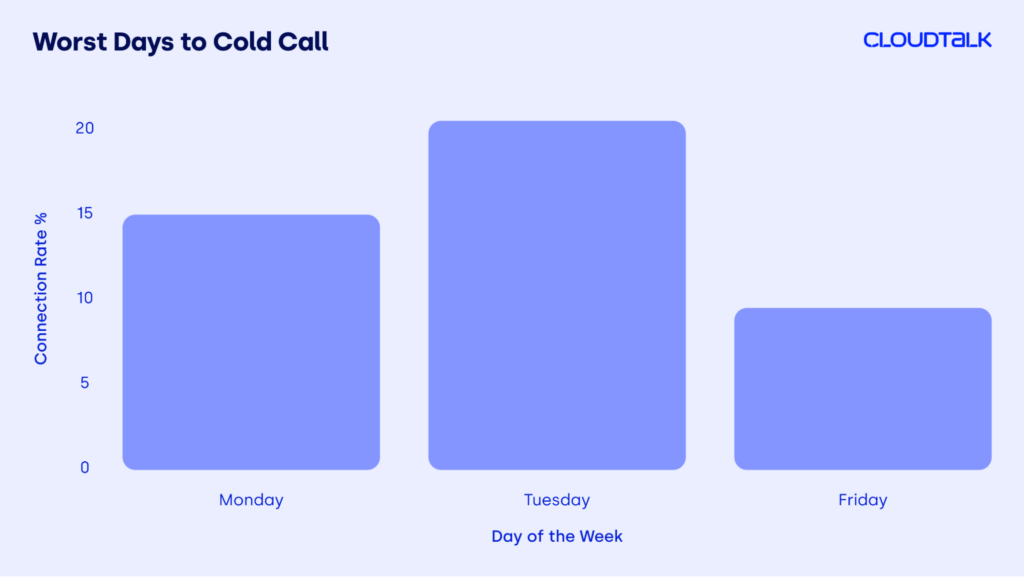
Worst Time of the Day to Cold Call
Sometimes, it’s also about knowing when not to call. Certain times of the day almost guarantee that your cold call will be ignored, sent to voicemail, or met with frustration.
Why?
Some times of the day are almost guaranteed to result in a poor response rate. Calling outside of business hours, early in the morning, or during lunch breaks is a surefire way to be ignored.
Stats:
- Before 10 AM is a busy hour. Most professionals are organizing their day, checking emails, or attending early meetings.
- 12 PM – 2 PM is lunchtime. prospects are either taking a break or away from their desks.
- After 6 PM is too late. Most professionals have wrapped up their work and are spending time with family or personal matters.
- Weekends and holidays are the worst possible times. Decision-makers are not working, and you risk annoying potential leads.
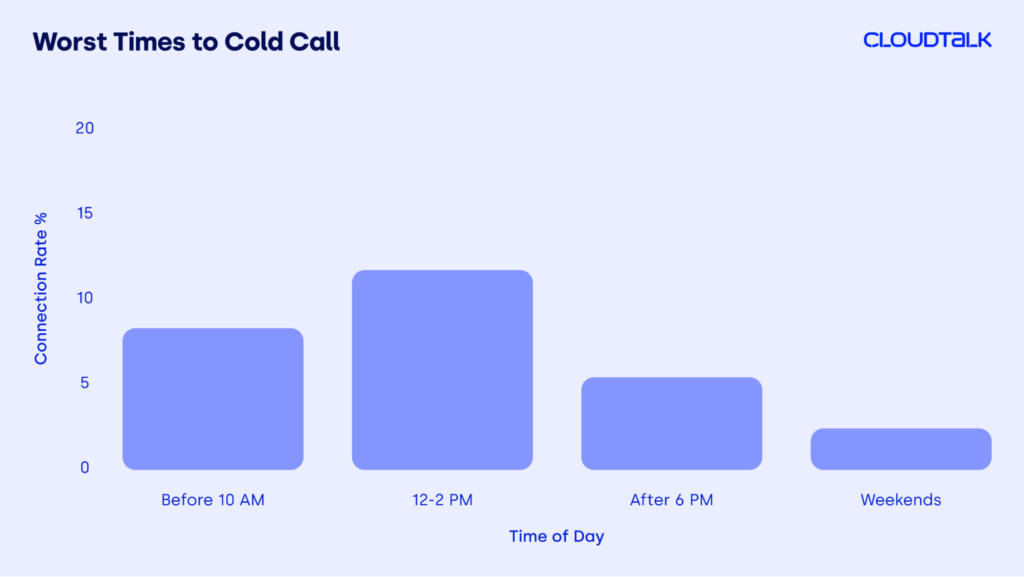
Additional Tips for Making Your Calls Successful
Even with the best timing, a smart strategy is key to cold calling success. Here are some additional tips to boost your results:
- Track Your Own Data: Industry-wide studies are helpful, but your business may have different patterns. Use a communication solution that helps you track and analyze your best call times.
- Don’t Overthink It: Timing matters. But if you’re debating whether to call now or later, the answer is simple, just call. Even outside ideal time slots, there’s always a chance you’ll get through.
- Leverage Technology: Providers like CloudTalk can help personalize outreach with features such as Call Flow Designer and AI-driven insights. Tailored conversations lead to more conversions.
- Follow Up Consistently: A cold call is just the beginning. Ensure you follow up, provide value, and establish clear next steps to move the conversation forward. The best way to do this is via automation.
How to Optimize Cold Calling Timing with Smart Features
CloudTalk is a cloud-based call system designed to enhance cold calling efficiency by helping sales teams reach prospects at the right time. With IVR, click-to-call, power dialers, your reps can streamline outreach and maximize peak calling windows.
Here’s more on how CloudTalk can help you scale your cold calling campaigns:
- CRM Integration: CloudTalk syncs with CRM systems, helping sales reps call at the right time with real-time customer insights for higher conversions.
- Call Monitoring & Coaching: Managers can analyze calls made during peak cold calling hours, providing feedback to improve timing and technique.
- Dynamic Call Routing: Calls are automatically directed to available reps during optimal calling windows, increasing answer rates and efficiency.
- Performance Analytics: CloudTalk tracks call success rates by time of day, helping teams refine outreach strategies for better cold calling timing.
Cold Calling Success: Strategy + Consistency
Timing matters, but consistency is the main contributor to cold calling success. Sporadic outreach leads to missed opportunities. Meanwhile, a structured prospecting routine keeps your pipeline full.
To make cold calling more effective and less stressful, use AI-powered tools like CloudTalk to automate dialing, score leads, and connect with the right prospects at the right time. Stay consistent, work smarter, and watch your conversions grow.
Find out how CloudTalk helps you structure your cold calling campaigns.
Sources:
FAQs
Does calling earlier in the day really work bette
Late mornings (between 10 AM and 11:30 AM) are generally better for cold calling. This is because most people have settled into their workday by then and are more likely to engage. Early mornings can catch prospects when they are busy or just starting their day.
What time of day is best to call?
Yes, it’s best to avoid cold calling during lunch hours (typically 12 PM to 1 PM). People are often away from their desks or focusing on personal time, which reduces the likelihood of getting a positive response.
How many times should I try calling before giving up?
Not always. The best time to cold call is typically mid-morning (10 AM – 12 PM) or late afternoon (4 PM – 5 PM), when prospects are more available.
What is the best time to call insurance leads?
The best time of day to make sales calls is between 10 AM – 12 PM and 4 PM – 5 PM, according to multiple sales studies.
Is 2 PM a good time to cold call?
No, the best time to sales call is mid-morning or late afternoon. 2 PM falls in the post-lunch slump, making it less effective.
How late is too late to cold call?
Telemarketing call times vary, but generally, calling after 6 PM is too late. What time can telemarketers start calling? Usually, 8 AM.























